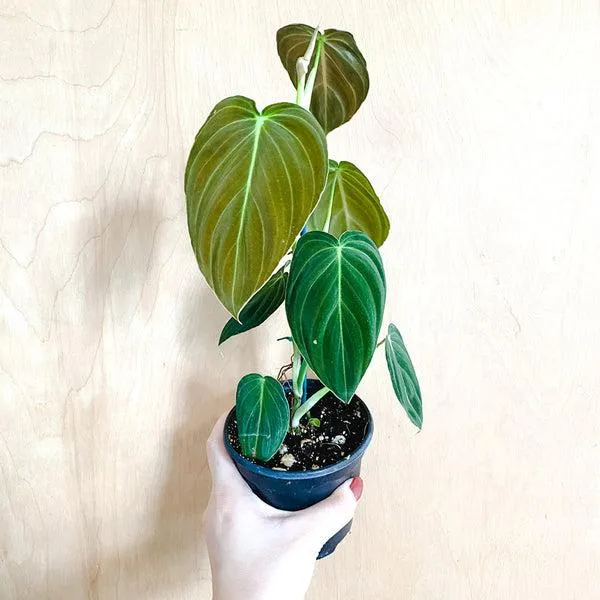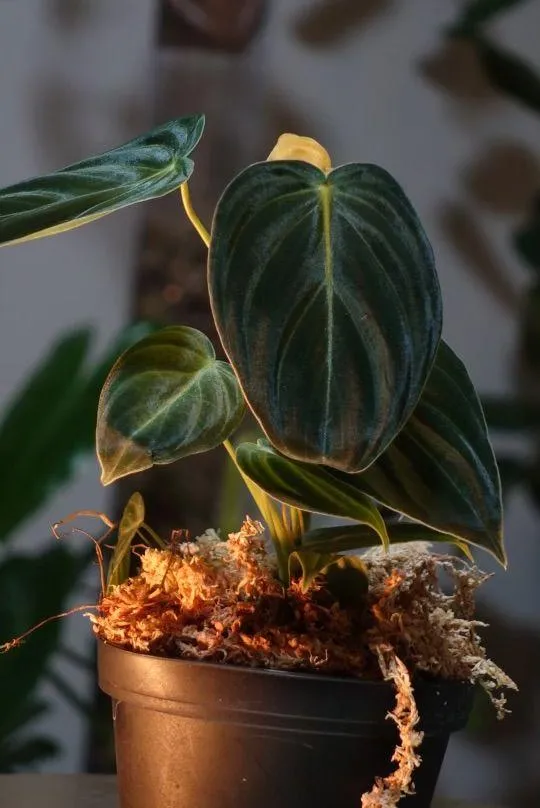Philodendron Micans vs Melanochrysum: A Comprehensive Comparison
As an avid plant collector, I’m often asked about the differences between various philodendron varieties. Two common questions I receive are “What’s the difference between philodendron micans and melanochrysum?” and “Which one should I choose?” In this article, I’ll provide a detailed comparison of these two beautiful trailing philodendrons to help answer those questions.
Appearance
At first glance, philodendron micans and melanochrysum look quite similar. They both have heart-shaped leaves arranged alternately on long, vine-like stems. However, there are some key differences in their appearance.
- Leaf color: Philodendron micans leaves are bright silver-green with a shiny, metallic sheen. Melanochrysum leaves are darker emerald green with hardly any silvering.
- Venation: The veins on micans leaves are quite prominent, thick, and silvery. On melanochrysum, the veins are less defined and blend in with the leaf color.
- New growth: New micans leaves emerge bright pinkish-red before maturing to silver-green. Melanochrysum leaves are always deep green from the start.
- Mature size: Micans has larger, showier leaves that can reach 10 inches long. Melanochrysum leaves max out around 6 inches.
From my experience caring for both plants, I’d say micans has a showier, more dramatic appearance due to its bright colors and silvery sheen. But melanochrysum still looks gorgeous in its deep emerald hue.
Growth Rate and Trailing Habit
While both are vigorous climbers, micans has a definite growth rate advantage. Given the same care, micans will put out new leaves twice as fast as melanochrysum. I’ve noticed micans can grow over 3 feet per year!
Their trailing habits also differ slightly. Micans sends out long vines that can cascade 4-6 feet from the pot. Melanochrysum tends to trail more tightly at 2-3 feet. So micans requires more space to properly display its full form.
The rapid growth of micans is ideal if you want fast covering of an arbor or poles. But its long vines could be seen as messy by some. Melanochrysum stays more compact.
Light and Water Requirements
When it comes to light, both do well in medium to bright indirect light. However, micans may scorch if exposed to direct sun for long periods. I find it’s happier with morning sun and protected from the hottest afternoon rays.
As for water, I’ve found melanochrysum to be slightly more tolerant of dry conditions than micans. It can bounce back from drying out somewhat faster. Micans prefers consistently moist soil to really thrive.

If care is average to poor, expect micans to decline or drop leaves more readily than the hardier melanochrysum. But with optimal care, both will prosper beautifully for years.
Pests and Disease Susceptibility
In my experience growing lots of houseplants, philodendrons are generally very pest-resistant. However, if infestations do occur, micans may be slightly more susceptible due to the softness of its new growth.
Spider mites in particular love the fuzzy new micans leaves. My melanochrysum crops have never had mite issues, possibly because its stiffer leaves are less appealing. Correctly watered plants also seem less prone to pests.
Fortunately, philodendron diseases are also quite rare. But if root rot were to strike from overwatering, micans’ frondier growth may mean it loses more leaves compared to tougher melanochrysum.
Price and Availability
When both were trending a couple years ago, micans babies sold for nearly triple the price of melanochrysum starts. While prices have leveled out some since, micans remains the pricier option.
Availability can also vary by region. In my local shops, melanochrysum seems easier to find year-round. Micans may only appear a couple times a year and sell out fast due to higher demand.
So in summary – while micans has greater showiness, growth rate and popularity, melanochrysum offers comparable beauty at a lower cost and with better availability and resistance to stress.
Which Variety Is Best for Different Situations?
To help determine which fits your needs best, here are some guidelines based on growing conditions:

High Light:
Micans if protected from direct sun. Otherwise melanochrysum is the safer pick.
Low Light:
Melanochrysum, as it can tolerate lower light better than micans.
Rapid Covering:
Micans for its vigorous growth to quickly cover poles or structures.
Tight Spaces:
Melanochrysum stays more compactly trailing.

Beginner Care:
Melanochrysum is hardier and more forgiving of average care.
Advanced Care:
Micans really shines if given optimal moisture and occasional fertilizer.
Low Maintenance:
Melanochrysum stays attractive with less attentive watering.
Dramatic Foliage:
Micans for show-stopping silver leaves and pink flushes.

So Which Variety Should You Choose?
Hopefully this breakdown has helped shed some light on the main differences between these two beauties! In summary:
- Micans has brighter, showier foliage but needs more precise care.
- Melanochrysum looks gorgeous in deep green and is more sturdy/forgiving of average care.
- Micans grows faster and has looser trailing habit while melanochrysum stays more compact.
- Micans is trendier and pricier but availability varies, while melanochrysum remains reliably findable.
Overall, I’d suggest micans for experienced growers wanting high drama or fast covering. Melanochrysum excels for beginners, low maintenance, or tighter spaces where its compact growth and sturdiness are better suited.
Both are wonderful plants! With proper conditions, I’m sure you’ll enjoy whichever one you choose. Just match it to your care level and needs. Good luck and happy philodendron growing!
Philodendron Micans vs Melanochrysum Comparison
| Characteristic | Philodendron Micans | Philodendron Melanochrysum |
|---|---|---|
| Leaf Color | Dark green with silver variegation | Dark green |
| Leaf Shape | Heart-shaped | Heart-shaped to ovate |
| Leaf Size | Up to 6 inches long | Up to 10 inches long |
| Growth Rate | Moderate | Moderate to fast |
| Light Requirements | Bright, indirect light | Bright, indirect light |
| Water Requirements | Allow soil to dry slightly between waterings | Allow soil to partially dry between waterings |
FAQ
- What is the difference between philodendron micans and melanochrysum?
Essentially philodendron micans has darker green leaves with a reddish underside and grows a little quicker than philodendron melanochrysum. Philodendron melanochrysum leaves are more of a golden color and have a silvery-colored underside. So in basic terms, the color and textures of the leaves are the main differences between these two types of philodendron plants. - Are micans or melanochrysum harder to care for?
At the same time, philodendron micans might be a little more simple to look after compared to melanochrysum. The micans variety favors bright indirect light and frequent watering. Whereas the melanochrysum can handle lower light and should not be wet so much. So if you’re a novice plant parent, micans may kinda be the safer choice because it’s more tolerant of errors. Nevertheless, with proper care both will do well. - How long does it take for new leaves to develop?
Typically, it takes around two to four weeks, or even sort of longer depending on growing conditions, for fresh foliage to sprout on philodendron micans and melanochrysum. Environmental factors like temperature, sunlight, and moisture levels can speed up or slow down the leaf formation process though. And of course, during winter dormancy periods leaf growth may pause for a bit before cranking back up in spring. - Is one more cold tolerant than the other?
From what certain experts say, micans has a bit more tolerance for cooler atmospheres than melanochrysum. The micans can take temps as low as 50F, whereas melanochrysum likes to be above 55F to preserve the quality of its golden leaves. Despite this, both plants will start to decline if frequently exposed to temperatures in the 40s. So in terms of chill resistance, micans could have a slight advantage. But they’re still, at heart, tropical plants, so heat is basically what makes them thrive. - How long before they need repotting?
Most growers agree that philodendron micans and melanochrysum should be up-potted whenever their root systems have fully filled the existing container – usually every 12 to 18 months. However, signs that it’s time to re-home the plant include roots sticking out the drainage holes or new growth slowing. The roots tend to bound quickly in their pots. On the other hand, over-potting can also cause issues like soil staying too soggy. So re-evaluating their root progression each year appears wise. - Can cuttings be propagated from these plants?
Indeed, propagating cuttings from both philodendron micans and melanochrysum is totally doable. Basically, just remove 5-8 inch sections of trailing stem that possess a few nodes, remove lower leaves leaving the top 2-3, and place the cut end into moistened potting mix or water. Within a few weeks to months fresh roots and even entire new plants can form. So propagating clippings grants an easy route for multiplying your micans or melanochrysum over time with minimum effort. Neat, huh? - Which one would you suggest for someone’s first philodendron?
Hmm, that’s a tough call! Based on my experience, i’d have to say that philodendron micans is perhaps a safer bet than melanochrysum for a philodendron newbie. Mainly because it grows quicker and doesn’t mind average household conditions as much. Even if minor mistakes are made, micans will likely survive and bounce back. Its shiny green leaves also add an amazing pop of color. However, if the new owner is very diligent about ensuring proper humidity and light levels, then either plant could work. The choice depends on their needs – dazzling gold looks or easier care. In the end, both are stunning varieties!
